Jerusalem artichokes, also known as sunchokes, are a root vegetable that some people love to hate. They have two things going against them, one being that they can completely take over your garden, the other that they have been known to cause gastric distress in some people. They didn’t get the nickname “fartichokes” for no reason! On the flip side, they are touted as an awesome permaculture plant and are sometimes thought of as a gourmet vegetable. I will show you how to cook Jerusalem artichokes, and hopefully you will understand why it really is a great tuber, even if you can’t eat it yourself.
All About Jerusalem Artichokes
Jerusalem artichokes are neither from Jerusalem nor a type of artichoke. They are actually related to sunflowers, and if you grow them you will see that they produce a yellow sunflower like flower. This is where the name sunchoke came from. No one really knows where the Jerusalem part came from, as they are not from that region, but it is theorized that the Italian word for sunflower, girasole, somehow morphed into Jerusalem. The artichoke part is likely because they taste very similar to artichokes when cooked.
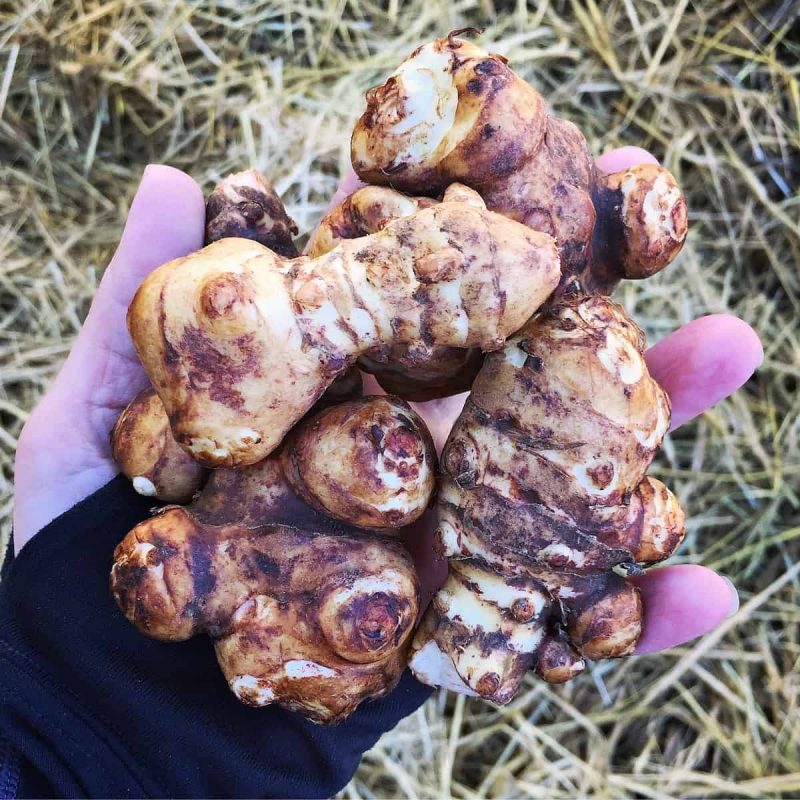
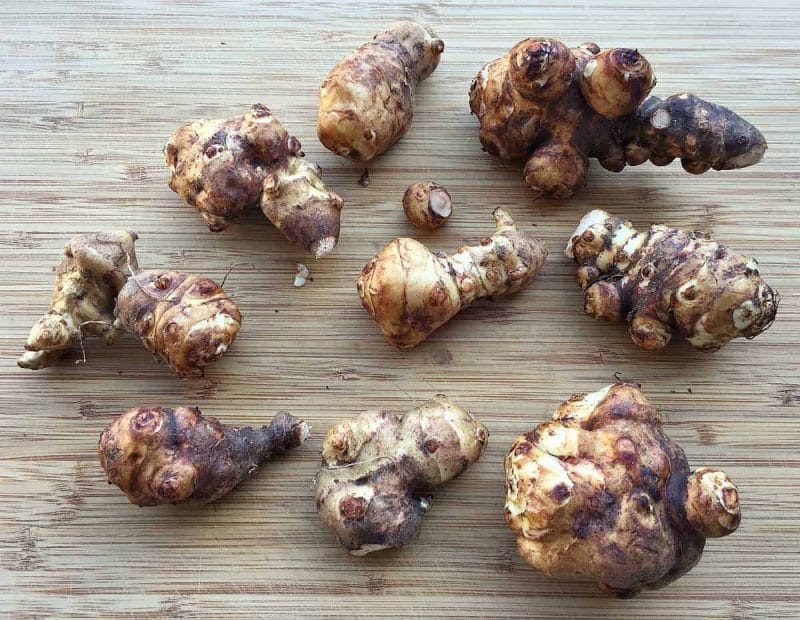
Some people are more sensitive to inulin than others, and can experience severe bloating and gas. For anyone who is new to eating Jerusalem artichokes, I would recommend eating only a small amount until you see how your body will react to them.
How to Cook Jerusalem Artichokes to (Hopefully) Make Them More Digestible
I’m not going to promise that everyone will be able to eat Jerusalem artichokes after cooking them this way, but for those who are only mildly affected this may help. If you are growing your own, it is best to wait to harvest them until after a frost. This will cause the breakdown of inulin to fructose, which is much easier for our bodies to digest. They will even continue to do this while in storage.
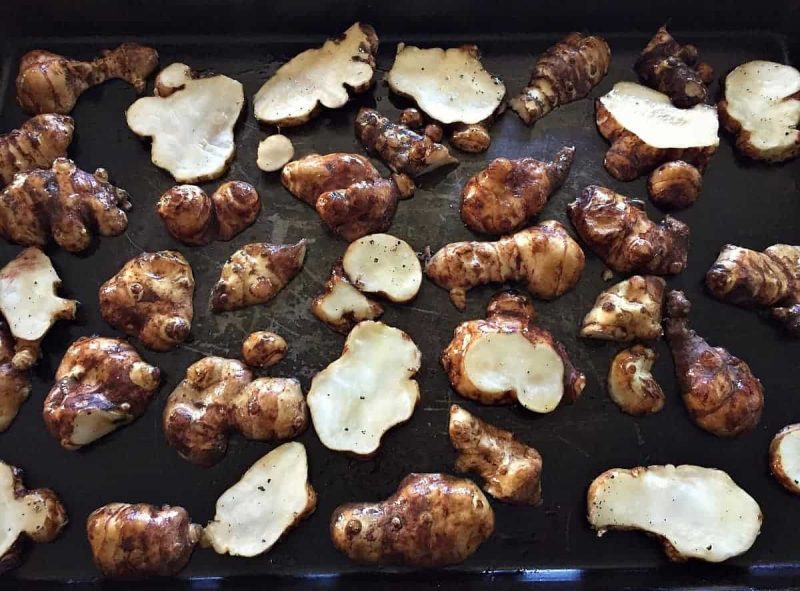
I thickly slice them and toss with olive oil, salt and pepper, and fresh herbs, then lay them in a single layer on a sheet pan. Slow roast them at 325°F for about 1 ½ hours, flipping halfway through.
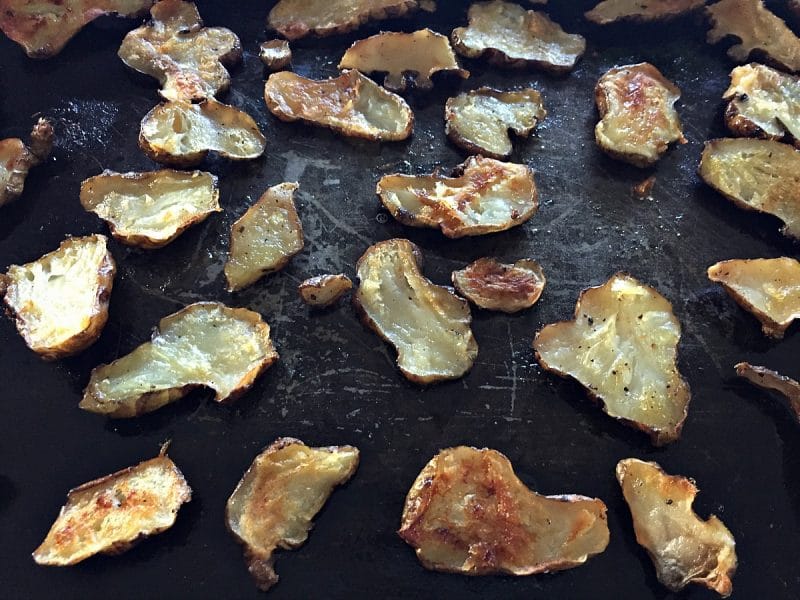
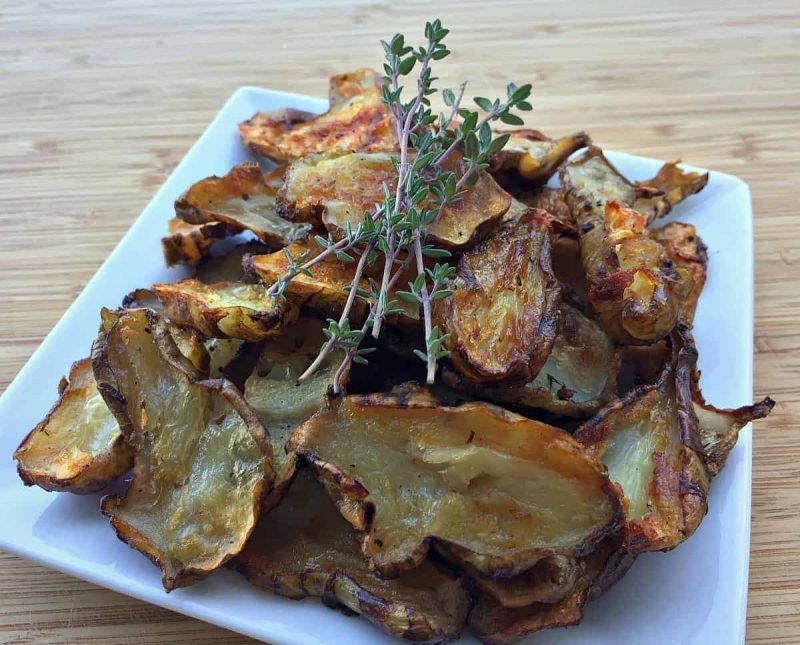
Here are some more ways to prepare Jerusalem artichokes that may help with digestibility:
- Fermented Jerusalem Artichokes
- Pickled Jerusalem Artichokes
- Jerusalem Artichoke Soup with Crispy Sage Leaves
- Jerusalem Artichoke Boulangeres
Have you ever tried Jerusalem artichokes?
Learn How to Cook Other Vegetables
Here are a few other not-so-usual vegetables you may need a little help learning to prepare in a way that makes you fall in love with them at first bite!
- 8 Ways to Eat Radishes & Their Greens
- How to Cook Turnips & Their Greens
- Easy Ways To Cook Winter Squash
- How to Cook & Eat Artichokes
- How to Cook Burdock Root
- What to Do with Cabbage
- How to Cook Beets & Their Greens
Slow Roasted Jerusalem Artichokes (Sunchokes)
Ingredients
- 1 lb jerusalem artichokes sliced
- 2 Tbsp extra virgin olive oil
- 1 Tbsp fresh herbs such as thyme or rosemary
- 1 tsp salt
- 1 tsp pepper
Instructions
- Heat the oven to 325*.
- Toss the artichokes with the olive oil, salt, and pepper. Lay the sliced onto a baking sheet in a single layer, leaving space in between each slice.
- Transfer to the oven and roast for 90 minutes, flipping once halfway through, until the outsides are crispy and the insides are creamy and tender.







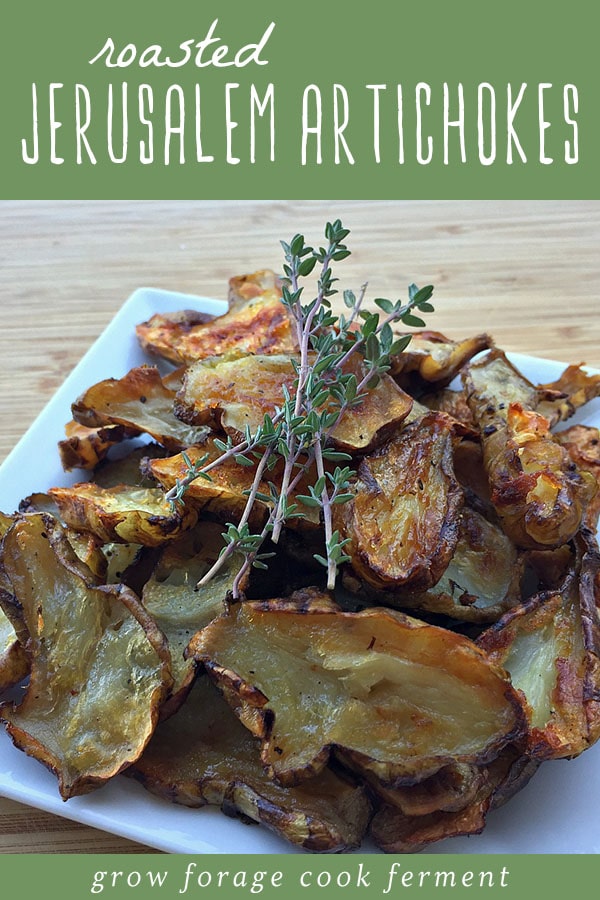


I have been growing these for 30 years or so and I have always ate them raw. After frost they are simular to a very crunchy carrot. I love them. I may try to cook some but the one time I tried, I really didnt like them. But they are awesome raw!!!
You’re right, David. They’re so delicious raw.
Do you peel them or just wash them?
It’s going to be time to try these again soon (frost), as our patch continues to expand. I’m planning to move some out to the barren area of disturbed earth from the pond and see if they will grow there, as all the damaged bits I’ve tossed into the tall grass have sprouted and spread. Thanks for sharing your recipe. Boiled and mashed led to quite a bit of gas production.
These grow wild here in Ohio and I have a 5×8 foot stand of them. My city calls them weeds and I have to reeducate them all of the time. Mine this year with all of the rains went to 25ft tall and started blooming first week of Sept. It is a beautiful site to see all of those small yellow sunflowerish flowers so high up…like they were reaching for the sun.
I let people know that when the first of the Europeans came to this country and were starving, the tribes taught them about this plant.
The only other food to give me gas as bad as sunchokes were chestnuts. However with the chestnuts, it took about a week or two of subsisting on them for 2/3 of my daily calories before it built up. With sunchokes, it took only one meal. Its a very uncomfortable sensation to have one’s intestines inflated. Sadly, these are two foods that I have to leave alone.
I heard that if you roast them with winter Savoy herb, it’s supposed to stop the gas and bloating! Going to try it this week.????
I will warn anyone who is interested in this plant that it will be invasive but with plenty of sheet metal deep enough in the ground around the area they are “somewhat containable”. They also will grow up to 20ft high and have beautiful little sunflowers on them which are great in arrangements.
As for recipes…I finely grate them up and make them into a relish…love it and so do others as long as they don’t know what they are eating. (mind over body thing)
Also sunchokes were a main staple of the Indians which they shared with the pilgrims to help them get through the winter months. You can harvest sunchokes all winter long as long as the ground doesn’t freeze…I just put straw over my patch and they don’t seem to freeze even in the odd Ohio weather.
i have a large stand of them along the fence line at my farm–makes a good barrier–the birds and bees love the flowers and seeds–a gift that keeps on giving
I tried Jerusalem artichokes for the first time today, and, right now I am thinking that no power on earth will ever induce me to do so again.
I followed a recipe from a vegan website that shall be nameless and tried to roast the things (unpeeled and cut in bite sized pieces) in the oven on Gas Mark 7. I was advised that they would need 25-30 minutes. After an hour and ten minutes they were still hard (!), so I resorted to microwaving them on full power for 5 minutes. They were STILL hard so they went back for another 3 minutes. I was becoming quite desperate at this stage and was in the mood for all-out war against them, and microwaved them for a further 5 minutes, after which I gave up! I found them quite inedible (although I quite liked the flavour, and my husband claimed to like them). Needless to say, my portion ended up in the bin.
Since finishing my meal I have been searching the internet to find out what I did wrong, and I am still perplexed. Comments on more than one website attest to the “yumminess” of this vegetable and state how “easy” it is to cook. Where did I go wrong????????
I can’t really say what went wrong as the method I use always makes them creamy and delicious. Maybe you cooked them at too high a temperature? Or maybe you just got old and tough roots. Try not to be discouraged, though! I promise you they are tasty :)
If the frost breaks down the inulin I have to wonder if putting them in the freezer for a day or two wouldn’t be a good strategy..
I’ve never tried it, but that sounds like a great idea to me!
Holy smokes those make my mouth water! Do you have any pictures of the plant itself you can share, leaves, flowers? Maybe one of your fantastic ID posts :)
Marvelous post! I harvested my first “small patch” from their contained raised bed and got about 3.5 gallons of tubers. I have enough to feed an army! Baked some up unsliced drizzled with olive oil & herbs and was so surprised how delicious they were. Can’t wait to try them sliced-baked and check out the additional recipes you posted. The only thing I can contribute is that you can store them easily in a bucket of clean fine mulch and they keep wonderfully and when growing you can do a trim-back on the main stalk to slow growth down but you have to trim while the stalk is still “full”, this means the center hasn’t hollowed out. Cheers!
I have eaten Jerusalem artichokes – my father had a garden where they multiplied like crazy! He would cook them along with roasting a chicken, soft and sweet, and often sliced them up raw in salads. None of us had any stomach issues with them, but I seem to remember they could throw your taste buds off for a short time.